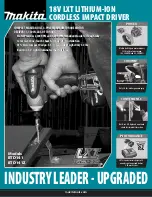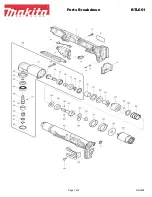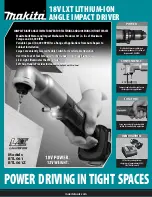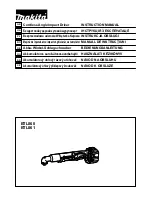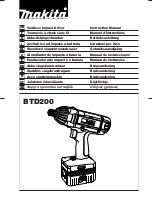
105
104
EN
EN
y
Do not hold the impact wrench with a wet or greasy
hand as the impact wrench could slip out of the hand.
y
Do not use the impact wrench in confined areas, other-
wise hand bruising may result as a result of potential
reactive torque.
y
Before work, make sure that the material being
worked on has no hidden electricity, water or
gas utility lines, etc. (if this can be reasonably
assumed).
Damaging these utility lines could result in injury and/
or material damages. To locate such utility lines, use
a suitable metal and electricity detector. Compare the
location of the utility lines with drawing documenta-
tion because detection devices may not necessarily be
accurate.
y
Hold the tool by the insulated grip parts of the tool
(handles), otherwise, in the case of damaged live
conductor wires, life threatening voltage could be con-
ducted through the uninsulated metal parts of the tool,
which could cause injury by electrical shock.
y
Avoid weakening the structure or damaging the tool,
e.g. by using it for demolition work or digging, modifi-
cations, which were not approved by the manufacturer,
guiding it along guide boards made from hard materi-
als, e.g. from steel, dropping it on the floor or pushing
it along the floor, using it as a hammer or using any
other force.
y
When using the impact wrench, the operator may have
unpleasant feelings in the hands, arms, shoulders or
other parts of the body as a result of vibrations. In the
event that the operator feels problems during work,
e.g. irregular pulse, tingling, whitening of the skin,
insensitivity in a certain part of the body, burning fee-
ling and stiffness, etc., stop working and consult these
problems with a medical doctor. The acting vibrations
have an effect on nerves and blood vessels in hands and
arms. When working in a cold environment, use warm
clothing and keep hands warm and dry.
y
Sound pressure and sound power values specified in
the technical specifications relate to the tool itself and
do not represent resulting noise at the work site. The
noise created at the work site depends, for example,
on the work environment, the workpiece, number of
insertions, etc.
Depending on the conditions and location of the wor-
kpiece, take steps to reduce noise, e.g. by placing the
workpiece on an underlay reducing the noise level, by
reducing the vibration of the workpiece by clamping it,
setting a lower possible operating pressure for specific
parts of the work, etc..
GENERAL SAFETY INSTRUCTIONS
y
In the event of multiple hazards, it is necessary to read
the safety instructions and understand them before
installation, performing repairs or maintenance, repla-
cement of accessories or when working in the vicinity of
tools for threaded connections. The result of not adhe-
ring to this requirement may be serious injury.
y
The installation, adjustment and use of tools for thread-
ed connections should only be performed by qualified
and trained personnel.
y
Tools for threaded connections must not be modified.
Modifications may lower the effectiveness of safety
measures and increase the risks for the user.
y
The safety instructions must be kept for future referen-
ce; must be provided to the user.
y
A tool for threaded connections must not be used when
damaged.
y
The tool must be periodically inspected to verify that
the nominal values and designations required by this
part of ISO 11148 are legibly marked on the tool. If
necessary, the employer/user, must contact the manu-
facturer to request a replacement label.
FRAGMENT EJECTION HAZARD
y
The user must be aware of the fact that as a result of
a defect on the workpiece or accessories or possibly of
the tool itself, high speed projectiles may be ejected.
y
Impact resistant eye protection must always be worn
while the tool for threaded connections is running. The
required level of protection must be individually asse-
ssed for each type of use.
y
A check must be performed to ensure that the workpie-
ce is securely fastened.
result in permanent hearing damage. Furthermore, if
necessary, wear suitable respiratory tract protection
because work with the tool may result in dust or other
materials being raised by the air being blown out of the
tool, which is damaging to health. In the event that it
is possible for dust to swirl up already during the use
of the impact wrench or during maintenance, then it
should not be inhaled and skin should be protected
against contact with this dust by means of gloves as it
may cause serious skin inflammation. Inhalation of dust
is damaging to health. During work, prevent access to
persons without protective aids, and animals.
y
Do not breath the expelled air as it contains pneumatic oil.
y
Do not point the expelled air at yourself or bystanders
or animals. The expelled air may leave greasy stains on
clothing. Compressed air may cause injury.
y
Before starting work, put aside any watches, jewellery,
secure loose clothing, long hair, etc. so these cannot
become caught in the rotating parts.
y
While working, ensure that you have a comfortable, yet
stable stance because when tightening/loosening reac-
tion impacts occur, which may result in the operator
losing balance. For this reason, do not use the impact
wrench on ladders, chairs, scaffolding or on other
insufficiently stable surface, e.g. if when moving from
one place to another it is necessary to use scaffolding,
stairs, ladders or roof battens, etc.
y
Work in a well lit location.
y
Do not touch rotating parts, injuries could result. Keep
your hands (hand) at a sufficient distance from the
work area.
y
Before work, check the drive tool (socket) for damage.
y
Do not use the impact wrench in an environment where
there is a fire or explosion hazard.
y
Do not carry the impact wrench while it is running.
y
For safety reasons, the trigger switch must not be loc-
ked in the pressed position.
y
During work, the drive tool or nuts and bolts may heat
up. Be especially careful not to burn yourself.
y
While working, make sure that the tool is running
smoothly: during any kind of non-standard operation or
unusual or increased noise, immediately turn the tool
off and identify the cause of this non-standard condi-
tion. If you are unsuccessful in remedying the defect
without it being necessary to perform a task inside the
tool, have it repaired at an authorised service centre for
the Extol® brand.
y
Never use the impact wrench for purposes other than
those for which it is intended.
y
For work, use only undamaged and not worn out drive
tools and attachments. This will reduce vibrations
and the risk of injury. Always use drive tools and atta-
chments intended for this type of tool.
y
Use only compressed air to drive the impact wrench,
never oxygen or other gases.
y
Never exceed the maximum compressed air operating
pressure for the impact wrench (6.3 bar).
y
Connect the impact wrench to the compressor only
using an air pressure hose with quick couplers.
y
When connecting an air hose to the impact wrench,
make sure that the trigger switch is in the „off“ position.
y
Regulate air pressure only by means of a reduction
valve.
y
Hold the pressure hose when disconnecting it to pre-
vent lashing.
y
Before exchanging the drive tool, repairs or maintenan-
ce, disconnect the impact wrench from the source of
compressed air.
y
Do not leave the impact wrench running without load.
y
Wait until the tang comes to a complete stop before
putting down the impact wrench.
y
Prevent the air hose from coming into contact with
sharp edges or high temperatures. In the event that the
hose is damaged, replace it.
y
Never pull the impact wrench by the air hose and do not
disconnect connections by pulling on the hose.
y
Never carry the impact wrench holding just the air hose.
y
The handle of the impact wrench should not be held too
rigidly, because a firmer grip transfers vibrations to the
hand of the operator.





























